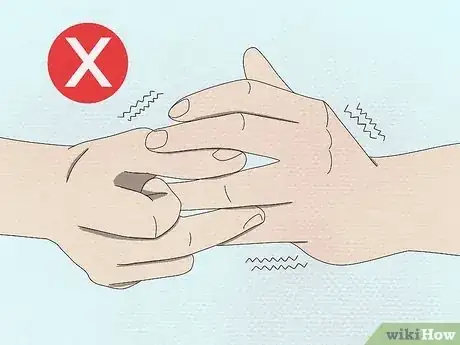This article was co-authored by Erin Conlon, PCC, JD. Erin Conlon is an Executive Life Coach, the Founder of Erin Conlon Coaching, and the host of the podcast "This is Not Advice." She specializes in aiding leaders and executives to thrive in their career and personal lives. In addition to her private coaching practice, she teaches and trains coaches and develops and revises training materials to be more diverse, equitable, and inclusive. She holds a BA in Communications and History and a JD from The University of Michigan. Erin is a Professional Certified Coach with The International Coaching Federation.
There are 21 references cited in this article, which can be found at the bottom of the page.
wikiHow marks an article as reader-approved once it receives enough positive feedback. This article received 15 testimonials and 91% of readers who voted found it helpful, earning it our reader-approved status.
This article has been viewed 708,153 times.
Intimidation is making others feel fear, nervousness, or inadequacy in order to gain social standing or produce a desired outcome. Although it is seen as a negative quality in many interpersonal interactions, it can be helpful in sports, business, and other competitive environments. Learning to be intimidating can also help you avoid being intimidated by others.
Steps
Being Physically Intimidating
-
1
-
2Fill the space.[3] Whenever you are sitting, standing, or walking, try and take up as much space as possible. This suggests that you command the space you are in and that you are confident in yourself.
- When walking, move with your arms open (swinging, out at your sides, etc.)
- When sitting, lean back, and keep your arms and legs loose and open.
- When standing, keep your legs apart and arms out whenever possible.
Advertisement -
3
-
4Stand in people’s way.[7] [8] [9] If you physically take up the space that others are trying to move through, they will either have to confront you or move to the side. Most people will want to avoid directly confronting you, and will either ask if you can let them by, or slip by without bothering you. Either way, you will appear intimidating.
- Try this technique by blocking hallways, staircases, doorways, etc.
- If you want to appear especially intimidating, if someone asks if you can please let them by, say something like “Oh, I didn’t notice you there.”
-
5Cross your arms.[10] [11] When standing, walking, or sitting, cross your arms over your chest. In many contexts, this can appear intimidating or aggressive.
- Make sure to cross your arms high over your chest, and do so firmly. If you cross your arms over your lower body, or loosely, it might convey nervousness rather than authority.
-
6Scowl.[12] While a smile can convey friendliness and agreeableness, a scowl suggests aggressiveness, anger, or displeasure. This can make people slightly afraid to talk to you, which may be desirable when you want to appear intimidating.
-
7
-
8Build muscles. Research shows mixed conclusions, but many believe that a muscular body leads to more assertiveness, and is deemed more intimidating by others.[15] If being muscular makes you feel more intimidating, then you just might come across this way. Try various body building techniques to increase your muscle mass.
-
9Don’t fidget. Tapping your hand or foot, shifting your weight from side to side, wringing your hands, and similar body movements convey a sense of nervousness.[16] [17] If you are trying to seem more intimidating, keep your body still and move deliberately. This type of body language signals assertiveness.
-
10Look well-groomed. Taking good care of your clothing and personal hygiene, and generally maintaining a good, clean appearance, helps convey a sense of assertiveness and confidence. Get in the habit of practicing a little personal grooming, and see if you come across as more intimidating.
- If you’re a man, consider growing a beard. Many believe that beards convey masculinity and assertiveness.[18]
- A suit, a nice dress or pants suit, or other formal wear can convey authority.[19] If you are trying to look intimidating, you might dress a little better than everyone else. For example, if standard dress at your workplace is business casual, you might seem slightly intimidating if you wear a full suit instead.
-
11Maintain a neutral facial expression.[20] Many of our emotions are conveyed through facial expressions—happiness by smiling, disagreement by frowning, shock by gasping, etc. If you maintain a neutral expression, and limit the amount of emotion you show, then you will come across as more intimidating.
- Practice not smiling, laughing, frowning, etc. in situations that normally call for these expressions. You can even practice in front of a mirror or with a friend to perfect this technique.
-
12Make eye contact. In many cultures, looking people in the eye is seen as intimidating.[21] Practice looking at people directly in the eye when you talk to them.[22] [23] [24] You may feel yourself coming across as more intimidating, and you may notice others reacting accordingly.
- In some cultures, making direct eye contact with people is a sign of disrespect.[25] [26] If there is a cultural taboo against looking people in the eye in your area or among the people you are working with, be very cautious about breaking it. You want to come across as intimidating, but you don't necessarily want to be rude or overly aggressive.
- Glaring at people, and rolling your eyes will also appear intimidating.[27] Be careful, however, because this may also seem rude in many contexts.
Being Socially Intimidating
-
1Speak clearly. Confidence, or a lack of it, is conveyed in the tone of one’s voice. If you mumble, hesitate, or whine when speaking, you may come across as non-assertive.[28] However, if you speak in a clear, even tone, and at a moderate to loud volume, you will exude self-assurance and seem positively intimidating.[29]
- If you have trouble speaking clearly or evenly, take a moment to think before you speak. This will give you time to prepare what you want to say. It may also convey that you are confident enough not to be bothered by a little silence, which can itself make you seem more intimidating.
-
2Be assertive when communicating. You can showcase your confidence in the way you communicate, thereby increasing your intimidation level. This means doing things like:[30] [31]
- Not always agreeing with others.
- Voicing your opinion.
- Not shying away from conflict.
- Using “I” statements, such as “I disagree” rather than “You’re wrong.” This emphasizes your authority.
- Agreeing in principle, but not necessarily in detail, by saying things like “That makes sense, but...”
- Not becoming defensive when others criticize you, and not offering counter criticisms. Instead, focus on making direct statements about your opinions.
- Being persistent. State your point over and over again if necessary, but don’t waver from it.
- Being willing to say “no” (or "I'm too busy," etc.) to some requests.
- If you're worried about being assertive, remind yourself that you are a powerful person who can make it through anything! The more you embrace this mentality, the easier it is to focus on pleasing yourself instead of pleasing other people.[32]
-
3Talk trash. “Trash” talk, or slightly criticizing others, is common in sports as a way of conveying confidence and unsettling opponents.[33] It can be used in other contexts, however (like political ads or in the workplace), to appear intimidating.
- Trash talk in other situations can be direct, such as telling a coworker “I’ve got thirteen new accounts listed in my report this month, Jim, and how many do you have? Zero.” It can also include sarcasm, like “Nice job on that report, Jim. Maybe next time you’ll actually win an account to include in it.”
- Avoid sexist, racist, and otherwise offensive language. Keep your trash talk focused on a person’s abilities rather than his or her identity.
-
4Have an entourage. Walking into a new place with a group of people at your back will make you look like you are powerful and important. The stronger and more confident the other people look, the less likely you are to be bothered. Having an entourage suggests that you are a leader, and can be intimidating in a positive way.
- In some locations, you can even rent an entourage for a short period of time.[34]
- Ideally, your entourage will be composed of good friends who support you and even idolize you.
- Your entourage can even act as your "wingman" by talking up your achievements and impressive qualities to others.
- Be kind to your entourage and treat them with respect. Make sure to listen to them and support their interests.
-
5Flaunt your achievements. If you have an impressive academic pedigree or honors and awards to show off, and are trying to appear intimidating at work, don’t be shy about decorating your office area with diplomas and certificates.[35] Having your achievements on public display will make you seem intimidating to anyone who stops by to talk.
- In order raise your intimidation level, you can also briefly mention your achievements in conversations as often as possible.
-
6Be mysterious. Sometimes silence speaks louder than words. Try keeping a little distance from others, not being too talkative, and seeming somewhat aloof. If you can cultivate a little mystery about yourself, others might be intimidated and curious about what you are really like.[36]
- Don't always speak up. Observe others and appear to listen carefully, but maintain an air of mystery.
- Always appear to be busy or occupied with something (such as reading a book or working on a notebook or tablet), but don't let others know what you are doing unless they ask.
- Whenever people ask about what you are doing, give short, vague answers that suggest mysterious importance. For instance, if a coworker sees you busy with a tablet and asks what you are doing, just say "Oh, it's this new work project. They probably haven't told you about it yet."
Community Q&A
-
QuestionHow can I tell if people think that I am intimidating?
 Community AnswerWalk straight at someone on the sidewalk. The faster they move out of your way, the more intimidating you are.
Community AnswerWalk straight at someone on the sidewalk. The faster they move out of your way, the more intimidating you are. -
QuestionHow do I look intimidating if I have a kind of a country look, with flannel and jeans?
 Community AnswerYou can be intimidating no matter what you wear. It's all about the energy you give off and being confident.
Community AnswerYou can be intimidating no matter what you wear. It's all about the energy you give off and being confident. -
QuestionWhy is my intimidation mistaken for shyness sometimes?
 Community AnswerMost likely you simply aren't intimidating. While trying to be intimidating, you simply remain silent and don't approach people. You may seclude yourself to seem less friendly, but in reality you look like you're scared to join the group. The number one thing is confidence. Stand up straight and be solid. If someone asks you to move, make eye contact with them and move slowly. If someone speaks to you, make eye contact with that person for a few seconds before you answer.
Community AnswerMost likely you simply aren't intimidating. While trying to be intimidating, you simply remain silent and don't approach people. You may seclude yourself to seem less friendly, but in reality you look like you're scared to join the group. The number one thing is confidence. Stand up straight and be solid. If someone asks you to move, make eye contact with them and move slowly. If someone speaks to you, make eye contact with that person for a few seconds before you answer.
References
- ↑ http://graziadiovoice.pepperdine.edu/how-to-get-taken-more-seriously-at-work/
- ↑ http://www.mayoclinic.org/healthy-lifestyle/stress-management/in-depth/assertive/art-20044644?pg=2
- ↑ https://www.portlandoregon.gov/police/article/61813
- ↑ https://www.michigan.gov/documents/mde/BSBD_UnitVII_Final_Student_Manual_April_17_2012_384891_7.pdf
- ↑ http://sandy.utah.gov/Home/ShowDocument?id=1736
- ↑ http://des.wa.gov/sites/default/files/public/documents/More%20DOP%20Services/EAP/Brochures%20and%20Posters/ViolenceWkplaceGuide-5-23-13.pdf
- ↑ http://sandy.utah.gov/Home/ShowDocument?id=1736
- ↑ http://des.wa.gov/sites/default/files/public/documents/More%20DOP%20Services/EAP/Brochures%20and%20Posters/ViolenceWkplaceGuide-5-23-13.pdf
- ↑ http://www.dol.gov/oasam/hrc/policies/dol-workplace-violence-program-appendices.htm
- ↑ http://sandy.utah.gov/Home/ShowDocument?id=1736
- ↑ http://des.wa.gov/sites/default/files/public/documents/More%20DOP%20Services/EAP/Brochures%20and%20Posters/ViolenceWkplaceGuide-5-23-13.pdf
- ↑ https://www.michigan.gov/documents/mde/BSBD_UnitVII_Final_Student_Manual_April_17_2012_384891_7.pdf
- ↑ https://www.michigan.gov/documents/mde/BSBD_UnitVII_Final_Student_Manual_April_17_2012_384891_7.pdf
- ↑ http://sandy.utah.gov/Home/ShowDocument?id=1736
- ↑ http://www.sscnet.ucla.edu/comm/haselton/papers/downloads/Frederick_Haselton_2007_Muscularity_sexy.pdf
- ↑ https://socialwork.buffalo.edu/content/dam/socialwork/home/self-care-kit/exercises/assertiveness-and-nonassertiveness.pdf
- ↑ http://www.mayoclinic.org/healthy-lifestyle/stress-management/in-depth/assertive/art-20044644?pg=2
- ↑ https://www.recruiter.com/i/why-beards-are-back-and-their-sociobiological-impact-on-job-interviews/
- ↑ http://careers.williams.edu/the-look-of-success/
- ↑ http://www.mayoclinic.org/healthy-lifestyle/stress-management/in-depth/assertive/art-20044644?pg=2
- ↑ https://socialwork.buffalo.edu/content/dam/socialwork/home/self-care-kit/exercises/assertiveness-and-nonassertiveness.pdf
- ↑ http://graziadiovoice.pepperdine.edu/how-to-get-taken-more-seriously-at-work/
- ↑ http://www.mayoclinic.org/healthy-lifestyle/stress-management/in-depth/assertive/art-20044644?pg=2
- ↑ http://sandy.utah.gov/Home/ShowDocument?id=1736
- ↑ https://www.nacada.ksu.edu/Resources/Clearinghouse/View-Articles/body-speaks.aspx
- ↑ http://home.ubalt.edu/ntsbpitt/ethics.pdf
- ↑ http://apps.pittsburghpa.gov/pcsc/09_EAP_Fall_Spvr_Bullying_Part1.pdf
- ↑ https://socialwork.buffalo.edu/content/dam/socialwork/home/self-care-kit/exercises/assertiveness-and-nonassertiveness.pdf
- ↑ https://www.portlandoregon.gov/police/article/61813
- ↑ http://www.mayoclinic.org/healthy-lifestyle/stress-management/in-depth/assertive/art-20044644
- ↑ https://socialwork.buffalo.edu/content/dam/socialwork/home/self-care-kit/exercises/assertiveness-and-nonassertiveness.pdf
- ↑ Erin Conlon, PCC, JD. Executive Life Coach. Expert Interview. 31 August 2021.
- ↑ http://vc.bridgew.edu/cgi/viewcontent.cgi?article=1191&context=br_rev
- ↑ http://m.kiplinger.com/slideshow/spending/T050-S001-surprising-things-you-can-rent/index.html?page=14
- ↑ http://www.askamanager.org/2013/04/should-i-display-my-degree-in-my-office.html
- ↑ http://www.healthguidance.org/entry/15676/1/How-to-Be-Intimidating.html
About This Article
If you want to look intimidating, stand up straight so you seem as tall as possible. You can also show that you’re confident by taking up as much space as you can whether you’re sitting, standing, or walking. For example, swing your arms when you walk and keep your legs loose and open when you’re sitting. In addition to making yourself look bigger, try crossing your arms firmly over your chest so you appear more aggressive. Another way you can seem aggressive is to scowl instead of smile. In addition to making your body look intimidating, you can act intimidating too by communicating assertively. To do this, always make your opinion known and play up your authority by using “I” statements like “I disagree with you.” For more advice, including how to make eye contact so you look intimidating, read on!

















































































